

"BALL BLUFF, 1900-1935"
from the book
"Prosper, Can You Tell Me More?"
by Leo Trunt
Published with Permission of the Author
Transcribed by Karen Klennert
For Purchasing Information, Contact Leo Trunt
"BALL BLUFF, 1900-1935"
from the book
"Prosper, Can You Tell Me More?"
by Leo Trunt
Published with Permission of the Author
Transcribed by Karen Klennert
For Purchasing Information, Contact Leo Trunt


The first mode of transportation in the area was by steamboats. They traveled the Mississippi River past Ball Bluff on their way up and down the river. The river boats served Ball Bluff from 1870 until 1920. The last steamboat to serve Ball Bluff was "The Lee". Some of the pioneer settlers of Ball Bluff were Ernest Johnson, John Relander, Waino Koski, John Nordberg, Peter Lundin, John Seppila, Alec Huhtula, Bill Anderson, Sam Makose, Jacob Thoe, Henry and Carl Norberg, Bill Bergholm, Joe Sander, and others. Jacob Thoe was very enterprising. He started the Thoe Land Company. He was fairly well off and was the first one in the community to buy a car.
On May 26, 1900, the community was officially organized as Ball Bluff Township and was recognized by the Aitkin County Board. The number of settlers continued to grow, and the need for a school became apparent. The first Ball Bluff school was built in 1900, and the first teacher was May Patterson. This school lasted until 1910, when a new school was built. About this time, a school was built on the west side of the river and called the Riverside or Siukola School. In 1917, the newest school was built at Ball Bluff and lasted until 1951 when it was closed down.

SECOND BALL BLUFF SCHOOL BUILT IN 1905
Picture Was Taken in 1992
Leo Trunt Collection
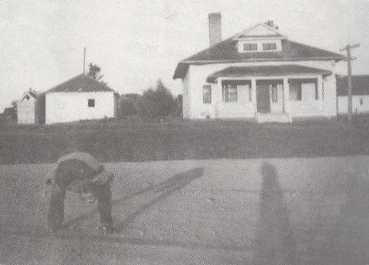
THIRD BALL BLUFF SCHOOL 1941 - 1951
Building on left is the woodshed
Courtesy Ida Anderson
(And it looks as if junior in the foreground is tempting teacher to send him to that woodshed!)
At the turn of the century, the need for a cemetery was realized. In 1901, John Relander donated the land for the cemetery. Jack Parker was one of the first to be buried there. Even so, Peter and Albertina Lundin were buried on their farm and not at the cemetery. In order to make some extra money, some of the farmers would work in the woods during the winter months. Much of the wood cut was cedar. Jacob Nordberg had this to say: "Dad used to cut cedar and other logs. He would build rafts out of the logs and float them down the river to Aitkin and the sawmill there. Then he would have to walk all the way back home. It would take several days to walk back. Dad would stay overnight at Palisade and other places along the way. Those days were tough!"
In 1915, the Swedish socialists built the Red Hall on the east bank of the Mississippi River. This hall was used for many social events. For a number of years, the Young People's Society held their meetings there. Eventually the hall was sold and was used to make the Ball Bluff Store.

1941 BALL BLUFF STORE
Courtesy Ida Anderson
Around 1915, Ball Bluff Township built a town hall on the east side of the Mississippi. Some people were against this, as there already was the Red Hall nearby.
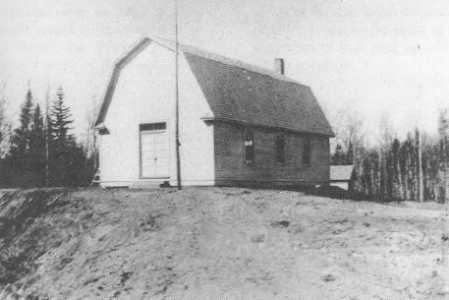
1916 BALL BLUFF HALL
Courtesy Ida Anderson
In 1916, Ernest Johnson and his brothers bought a sawmill and operated it in the Ball Bluff area until 1929, when it burned down. One reason for the importance of Ball Bluff was the fact that it was a major crossing point. The ferry was built there in 1918, and it was the easiest place to cross the Mississippi River. The nearest bridge was at Blackberry or far to the south. There was a ferry at Mississippi Junction, but that was on the north side of the Swan River and would still require crossing the Swan River. The ferry at Ball Bluff was not motorized and required man power to pull the ferry across. A system of ropes were used to pull the ferry from one side of the Mississippi to the other. Two row boats were stationed at the ferry site in case the ferry was on the wrong side of the river.
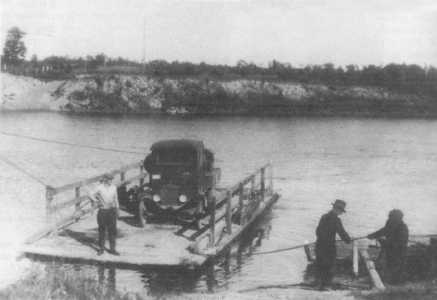
1926 BALL BLUFF FERRY (by the Farmers Hall)
Leino Nuorala on the ferry with the Model T. Mike Nuorala and Adam Heikkinen on shore
Courtesy Sylvia Hill
After the labor problems the Finnish people experienced on the Iron Range in the teens, a large number of them came to settle in Ball Bluff. They mostly settled on the west side of the Mississippi River and formed a close Finnish community. Many of the people were firm believers in the coooperative and socilaist movements of the time. The Finns of the west side of the Mississippi came over to some of the events on the east side of the river at the Red Hall. By 1920, they began to discuss the need for building a commuity hall of their own. Consideration was given to purchasing the old Red Hall, but as the land that the Finns had bought was not near the hall, it would be too difficult to move it. It was decided to build one themselves. A basket social was held to raise funds for the hall and each farmer agreed to donate 10 logs which would be delivered and sawed into lumber. Emil Siukola agreed to saw them up at his mill. By July of 1921, the hall was finished.
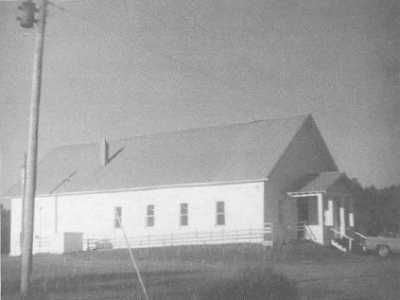
FARMERS HALL
Leo Trunt Collection
In 1921, the Finns formed their own group and called it the "Farmer's Social and Educational Society". The first board of directors were William Liimatainen, Emil Siukola, Jacob Punkka, Charles Kivela, Nels Lapinoja, Emil Kauppola, and Armas Puro. Over the years, there were about 40 to 50 active members of the hall. dances were held, speakers came to talk, plays were held, and many other events occurred at the hall. Money was raised for donating to various socialist causes throughout the country. Various clubs met at the hall such as the Women's Group, Athletic Club, Young People's Organization, and the Co-op Guild. The hall had a library with a good selection of books, a piano on the stage, and furniture to use in plays. However, interest waned, and the hall was sold in 1927 to Gust Hill for $300.00. After that, the meetings were held at the public hall at Ball Bluff.
In 1920, the Ball Bluff Store was built by Isaac Sall. It changed hands many times over the years. During the 1930's, there was a cream station in the store building. A man came who wanted to start a cheese factory, but he went to Goodland instead. Around 1920, a combination potato warehouse and depot were built on the Hill City Railroad at the Seaver location. Many of the west side farmers would bring their potatoes to this warehouse to be shipped for sale.
After the steamboats stopped their operations in 1920, a man by the name of Frank Riggs got a contract to haul mail up and down the river with a speedboat.
In the early 1920's, the first phone system came to the community. It was put in by McGregor people and was a one wire ground system. By 1925, the township put in a two wire phone/fire call system of their own. It was tied to the Cornish fire system and had outside links to other systems. A phone office was set up at Ball Bluff, and the system stayed local for many years. Eventually, the system was sold to Northland Phone Company.
During the mid 1920's, the Hill City Woodenware Factory had steam haulers operating in the Ball Bluff area. They had a turn around loop north of Boot Lake and ice roads went all the way to Mississippi Landing, where the hardwood timber was loaded onto the train cars. A lot of birch and other timber were taken out of the Ball Bluff area.
There were a number of logging camps near Ball Bluff in the 1920's. Some of the loggers were Jasper Pogue, Mr. Lofgren, and Mr. Unge.
The farmers on the west side of the river had an organization called the Finnish Farmers Club. In 1933, they built the Farmer's Hall, and it is till in operation to this day.
In 1934, the state built a fire tower on Ball Bluff hill. It was 60 feet tall. In 1936, a new tower was built, and the old tower was taken down.
The people of Ball Bluff wanted a church that was closer to them and would better serve the people. In 1934, the Carmel Lutheran Church was built and is still serving the community to this day. By the mid thirty's, the Ball Bluff area had settled down from its booming days and became a sleepy farming community.
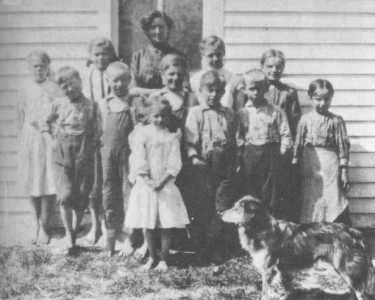
LOBERG SCHOOL IN 1912
Back L to R: Martha Tervo, Ida Tervo, teacher Ester Wiggins, Anne Whohella, Lulu Kumpula
Front L to R: Elmer Loberg, Toivo Saari, Pearl Saari, Enoch Saari, Enoch Kumpula, Eric Tervo
Courtesy Enoch Saari
The settlers relied on farming and some logging as their main forms of income. One of the early farmers was Abe Palon. He operated a large pig farm just south of the school. The pigs would roam all over the place, and Abe had a number of farm hands who would watch over them.
Deaths came to the Loberg community, and a place was needed for burials. It was too far to bring the interns to Ball Bluff or other cemeteries. Besides, the people wanted their loved ones to be near them. Otto Coleman said he would donate a spot for the interns near his farm. The first intern was placed there in 1908. Most of the interns were infants and thirteen burials were placed there in all. A tragic event took place in the spring of 1922. The local teacher for the Loberg School disappeared without a trace.. No one ever knew what became of her."Word was received here yesterday morning from Swan River of the mysterious disappearance of Miss Margaret Peterson, a school teacher in district 87, five miles south of Swan River, and twelve miles from Jacobson, where the young woman's mother lives. Miss Peterson was last seen April 1 and the supposition was she had gone home. When no word came from her, it was discovered she had not been there. This was her first year of teaching and she had made an excellent record as a painstaking, conscientious instructor, devoted to her work. Conditions were such she did not prepare herself for teaching until later than the majority of girls who enter the work. She was a graduate of the Virginia High School. The farm house where Miss Peterson boarded was destroyed by fire a few weeks ago and she lost all her clothing, which may have preyed on her mind as she was of a nervous temperament and it also thought she may have lost her life when attempting to cross the Mississippi River. Those who knew her say she was not the type of girl who would attempt to do anything spectacular for notoriety." (from Aitkin Age--April 22, 1922)
By 1935, the number of school children had decreased to such an extent that the Loberg School was closed and sold to Elmer and Alice Loberg for $200.00.
The area remained a quiet little farming community for many years and remains so to this day.

BACK
HOME